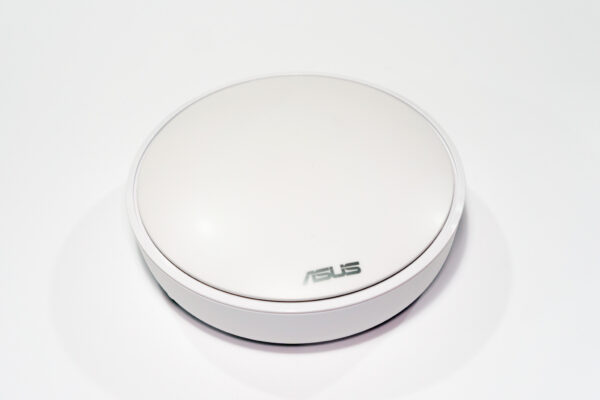ASUS has entered the arena of whole-home mesh Wi-Fi systems with the launch of their Lyra Home Wi-Fi System in July this year. It comes in a three-piece system, somewhat like the TP-Link Deco M5 I reviewed earlier, so you’re all set to cover homes of up to 6,000 square feet with AC2200 Wi-Fi in no time.
The ASUS Lyra system comprises three identical units, each one a white circular disc-shaped device similar to the TP-Link Deco M5. The Lyra is somewhat larger though, measuring 149.8 mm in diameter and 49.5 mm high. It looks good, but I think not quite as good as the Deco M5, though this could be a matter of personal opinion. The Lyra also similarly comes with two Gigabit Ethernet ports in each unit. For power, however, the Lyra uses a dedicated 12V DC input jack, instead of USB-C.
The ASUS Lyra has a dedicated pairing button on the side of the device. There’s also a reset button on the underside. The top of the Lyra is covered with multi-coloured LEDs used to indicate status of the device.
Since all units are identical, any one of them can be the main router connected to your broadband. Furthermore, either of the Gigabit Ethernet ports can be used as the WAN port for connecting to the Internet; this is automatically detected during setup.
Setting up the ASUS Lyra is easy. Start by installing the ASUS Lyra mobile app from the Android or iOS app store, then follow the in-app instructions.
Once the first Lyra device is found, you’ll have a few more questions to finish setting up the network.
This will get you started. But of course, you want to add the other two Lyra devices to the network, and to that end, the ASUS Lyra mobile app provides advice on how to locate them.
The ASUS Lyra is rated AC2200, with up to 400 Mbps on the 2.4 GHz radio, and up to 867 Mbps on each of two 5 GHz radios.
I’ll write about performance in a separate comparison post with other mesh Wi-Fi systems I have on hand. But I’ll expect the ASUS Lyra to perform better from the remote satellite nodes than the Aztech AIR-706P and TP-Link Deco M5, because the Lyra uses a dedicated 5 GHz radio for backhaul communications. This does mean that the AC2200 speed is not entirely available to end-user mobile devices.
As you’ll expect of mesh Wi-Fi systems, the ASUS Lyra broadcasts a single Wi-Fi SSID so there’s only just one single network for your mobile devices to communicate with.
Users who like to manage their routers through a conventional web-based interface will be happy that the ASUS Lyra offers one. It looks pretty much similar to other ASUS router devices, and hence users of other ASUS router devices should find the ASUS Lyra web interface very familiar and comfortable to navigate around.
Unfortunately, the capabilities available through the web interface is different from the mobile app. Some things can only be done through the web, while others only through the mobile app.
The interface differences aside, the ASUS Lyra supports the ability to setup a VPN server, QoS (by applications only, not devices), and AiProtection. The latter is a feature in several of ASUS router products that provides protection to the entire network using an intrusion prevention system (IPS) and sophisticated deep packet inspection engine to block malicious or suspicious traffic.
AP mode (or bridge mode) is not supported in the firmware of the ASUS Lyra when it arrived. However, a new firmware available now lists AP mode as a beta feature. I will test that out in due course.
The ASUS Lyra is available from Challenger and Hachi.tech at S$599 (usual price S$659).
Conclusions
Pros:
- Pleasant design
- Easy to setup and deploy
- Managed with mobile app or conventional web interface
Cons:
- Doesn’t use USB-C power
- Different capabilities between web interface and mobile app

